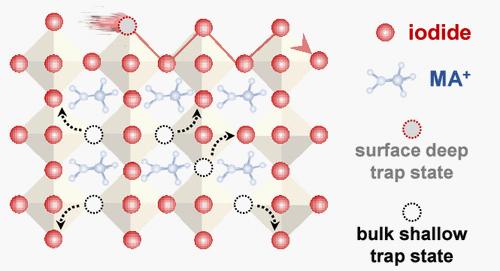具有不同空间和能量分布的陷阱态对金属卤化物钙钛矿中离子迁移动力学的具体影响
IF 9.1
1区 材料科学
Q1 CHEMISTRY, MULTIDISCIPLINARY
引用次数: 0
摘要
陷阱态工程已被广泛用于操纵金属卤化物钙钛矿(MHPs)中的离子迁移动力学,这是与基于MHPs的器件的性能和稳定性相关的关键因素。然而,由于其复杂的空间和能量分布,人们对不同陷阱态的具体作用知之甚少。在此,我们提出了一种独立调节MHPs中大块浅阱态和表面深阱态分布的方法。通过将原位光致发光光谱与宽视场成像显微镜相结合,我们阐明了表面阱态对促进粒子间远程离子迁移的影响。有趣的是,我们通过时间分辨光电技术确定,大多数涉及离子迁移的移动离子缺陷主要是由体阱态造成的。我们的研究结果表明,有针对性地操纵大块浅阱和表面深阱状态可以有效地减少移动离子的数量和减缓离子迁移的速度。本文章由计算机程序翻译,如有差异,请以英文原文为准。

Specific Influences of Trap States with Distinct Spatial and Energetic Distributions on Ion Migration Dynamics in Metal Halide Perovskites
Trap state engineering has been widely employed to manipulate the dynamics of ion migration in metal halide perovskites (MHPs), a crucial factor associated with the performance and stability of MHP-based devices. However, the specific roles of different trap states remain poorly understood due to their complicated spatial and energetics distributions. Herein, we propose a methodology for independently regulating the distributions of bulk shallow and surface deep trap states in MHPs. By combining in situ photoluminescence spectroscopy with wide-field imaging microscopy, we elucidate the effect of surface trap states on promoting long-range interparticle ion migration. Interestingly, we ascertain with time-resolved photoelectric techniques that the majority of mobile ionic defects involved in ion migration are predominantly contributed by bulk trap states. Our findings suggest that targeted manipulation of bulk shallow and surface deep trap states can be effective in reducing the number of mobile ions and decelerating the rate of ion migration, respectively.
求助全文
通过发布文献求助,成功后即可免费获取论文全文。
去求助
来源期刊

Nano Letters
工程技术-材料科学:综合
CiteScore
16.80
自引率
2.80%
发文量
1182
审稿时长
1.4 months
期刊介绍:
Nano Letters serves as a dynamic platform for promptly disseminating original results in fundamental, applied, and emerging research across all facets of nanoscience and nanotechnology. A pivotal criterion for inclusion within Nano Letters is the convergence of at least two different areas or disciplines, ensuring a rich interdisciplinary scope. The journal is dedicated to fostering exploration in diverse areas, including:
- Experimental and theoretical findings on physical, chemical, and biological phenomena at the nanoscale
- Synthesis, characterization, and processing of organic, inorganic, polymer, and hybrid nanomaterials through physical, chemical, and biological methodologies
- Modeling and simulation of synthetic, assembly, and interaction processes
- Realization of integrated nanostructures and nano-engineered devices exhibiting advanced performance
- Applications of nanoscale materials in living and environmental systems
Nano Letters is committed to advancing and showcasing groundbreaking research that intersects various domains, fostering innovation and collaboration in the ever-evolving field of nanoscience and nanotechnology.
 求助内容:
求助内容: 应助结果提醒方式:
应助结果提醒方式:


